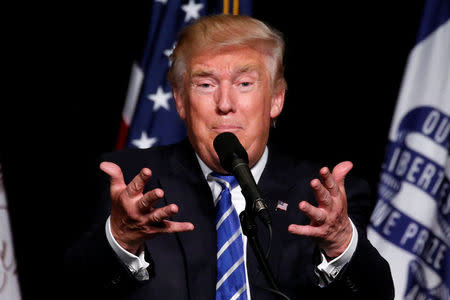The year of 'Neither': Why Reuters/Ipsos is tweaking its U.S. presidential poll
By Maurice Tamman NEW YORK (Reuters) - In a presidential campaign notable for its negativity, the option of “Neither” candidate appears to be an appealing alternative, at least to participants in the Reuters/Ipsos opinion poll. Many voters on both sides have been ambivalent in their support for Democratic nominee Hillary Clinton and Republican nominee Donald Trump, complicating the task of the pollsters trying to track the race. That sentiment may help explain an apparent skew that recently emerged in the Reuters/Ipsos poll results. Given the choice, a relatively large group of voters opted for “Neither/Other” candidate compared with other major polls, leading to an underreporting of several percentage points for one or other of the two major contenders at times in the race. As a result, Reuters/Ipsos is amending the wording of the choice and eliminating the word “Neither,” bringing the option in line with other polls. The amended Reuters/Ipsos tracking poll will be published later Friday, available at http://polling.reuters.com. GAPS FOR TRUMP, CLINTON From the beginning of June until the middle of July, the Reuters/Ipsos survey showed consistently lower support for Trump than other polls were capturing. At times, the Reuters/Ipsos poll showed Clinton with a lead over Trump as wide as about 12 percentage points among registered voters - five percentage points higher than Clinton’s lead in some other comparable polls. To determine the cause, the pollsters examined what made the Reuters/Ipsos poll different. Their conclusion: By giving respondents the option of "Neither/Other," the survey appears to have captured greater numbers of ambivalent voters unwilling to commit to either candidate than other major polls, which only offer the choice of “Other.” During the period analyzed, the historically high antipathy for both major candidates, paired with the option of selecting “Neither/Other,” meant the Reuters/Ipsos poll probably underreported Trump’s support before the Republican convention, perhaps by 3 to 5 percentage points. More recently, the “Neither/Other” option appeared to lead to an underreporting of Clinton’s support in the run-up to the Democratic convention, said Cliff Young, pollster and president of Ipsos Public Affairs, which partners with Reuters on the poll. The pollsters estimated the Clinton shortfall at 2 to 4 percentage points. Tom W. Smith, director of the Center for the Study of Politics and Society at the University of Chicago, said the earlier Trump numbers in the Reuters/Ipsos poll could have indicated a softness of support for Trump among a relatively small group of conservative voters who had yet to come to terms with his candidacy. It is plausible that a similar effect among Democratic voters may be hitting Clinton now when presented with the option of “Neither,” he said. And the skews displayed by the “Neither” phenomenon may indicate there is a chance for some gains among alternative party candidates, Smith said. Tim Mclheny, a 47-year-old civil servant from Vermont who describes himself as a moderate Republican, is a case in point. When asked in the Reuters/Ipsos poll who he will vote for in November, he skipped both Trump and Clinton and opted for “Neither/Other.” “It is the lesser of two evils,” Mclheny said. He said he will cast his ballot for the candidate he believes will do the best for civil servants. Ultimately, however, he said he may well grudgingly opt for Trump come November. THE ‘NEITHER’ SKEW Here’s how the pollsters reviewed their methodology and decided to drop “Neither.” Ipsos tested three alternate versions of the presidential preference questions on different groups in a survey and compared those results to the outcome of the established version of the tracking poll. That test found eliminating the word “Neither” from the “Neither/Other” response increased Trump support by between 3 to 5 percentage points on any given day leading up to the Republican convention. It also increased Clinton’s support, but by a smaller margin. http://spotlight.ipsos-na.com/?p=5574 Since the convention, however, Trump’s support seems to have solidified among wary supporters. Now, the “Neither” issue appears to be affecting Clinton in the survey. On Tuesday, for example, the established tracking poll had the candidates tied at 38 percent each. A 13-point lead for Clinton on July 14 had vanished in two weeks. (http://polling.reuters.com/#poll/TM651Y15_13/filters/PD1:1/dates/20160701-20160726/type/smallest) But eliminating “Neither” from the “Neither/Other” answer produced a different result. In that case, Clinton was ahead, 40 percent to 36 percent, on Tuesday. When asked the question in the new way, 11 percent of voters opted for “Other.” By comparison, 14 percent opted for “Neither/Other” in the version of the survey that showed the race tied. The three-point gap suggests the “Neither” phenomenon was now working against Clinton. In the nearly five years Reuters/Ipsos has been offering the “Neither/Other” option to respondents in presidential polling, it has never yielded such a skew. The results highlight how poll designs and methodologies can yield significantly differing results, and how important differences can emerge from the way a question is framed. The Economist/YouGov poll, like the Reuters/Ipsos survey, is conducted online. It uses a similar battery of questions, but does not offer the “Neither/Other” option, just “Other.” In Economist/YouGov’s July 17 poll, Clinton was ahead by 4 percentage points among registered voters, with Trump at 41 percent. The NBC News/SurveyMonkey online poll gives three options: Clinton, Trump, or “No Answer,” which more firmly prods respondents to make a choice. In their July 17 poll, Clinton led Trump by one point, 46 to 45, among registered voters. Telephone polls tend to ask voter preference as an open-ended question, or just offer respondents the choice of the Democratic and Republican candidates. Among phone polls, such as the ABC News/Washington Post and NBC/Wall Street Journal surveys, Clinton recently led by four to five points. The CBS/New York Times telephone poll of registered voters had the race tied at 40 percent each. The Reuters/Ipsos presidential-preference poll result and other results in the survey are updated twice a week. (Reporting by Maurice Tamman in New York. Edited by Kevin Krolicki.)



